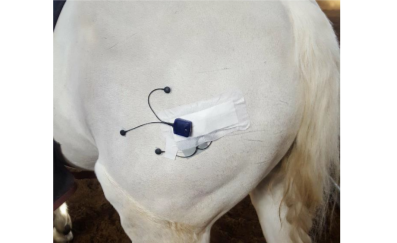Rehabilitation exercises improve hind leg muscle activity in horses
EMG
A research poster by Harper Adams University using Myon m320 EMG sensors examines the need to quantify the value of remedial exercises in horses.
A recent undergraduate has been objectively quantifying the value of common remedial exercises for horses which aim to improve hind limb muscle activity.
A condition of the stifle joint, known as intermittent upward fixation of the patella (IUFP) is characterised by the stifle joint becoming fixed when in extension. This interrupts the movement of the horse and surgery could be required if the case is severe. If it is milder, remedial exercises to improve the hind limb muscle tone may be suggested.
Remedial exercises which are commonly used include: pole work; incline work; backing-up; and lateral tail pulls. However, there is a lack of objective research on their value in improving muscle tone. The electrical activity which working muscles emit can be measured using electrodes and transmitters placed on the skin, in a process known as surface electromyography. This could be used to compare muscle activity and assess the value of these exercises.
Study aim
This study aimed to investigate the potential of: backing-up; walking over ground poles; walking over raised poles; and lateral tail pulls; to increase the activity of two hind leg muscles – the Vastus lateralis (VL) and the Biceps femoris (BF).
Methodology
After a pilot study, ten clinically-sound riding horses were selected at a livery yard. The electrodes and transmitters were attached to the skin surface of the two chosen hind leg muscles (VL and BF) on each side of the horse. The exercises, conducted in teh same order and repeated three times, for each horse, were: walking; walking over poles;backing-up; walking over raised poles; and lateral tail pulls. Each horse acted as its own control.
Outcomes
Walking over poles and raised poles increased the muscle activity in both of the chosen hind leg muscles (VL and BF), compared to walking on level ground. These two exercises could offer potential benefits to help treat the stifle condition, IUFP. Backing-up increased the BF but not the VL muscle activity, but the horses were not previously trained in this technique. Lateral tail pulls may only be beneficial if horses are unable to undergo walking exercises.
Research
This research note outlines the work of an honours research project by Chloe Blyth, Undergraduate on the BSc (Honours) degree in Veterinary Physiotherapy, 2018. View the full research poster here.
Supervisor: Carole Brizuela, MRCVS, Senior Lecturer in Animal Health, Programme Manager for Veterinary Physiotherapy, Harper Adams University.
Further research
Further research would be beneficial to investigate the effects of trotting over poles and being ridden over poles. A repeat trial of backing-up with trained horses would be useful. Different lateral tail pull techniques could also be compared.
Acknowledgements
The owners of all the horses used in the study are gratefully acknowledged.
For more info
If you would like to find out about the EMG systems we offer, please click here to read more or contact us for a quote.

